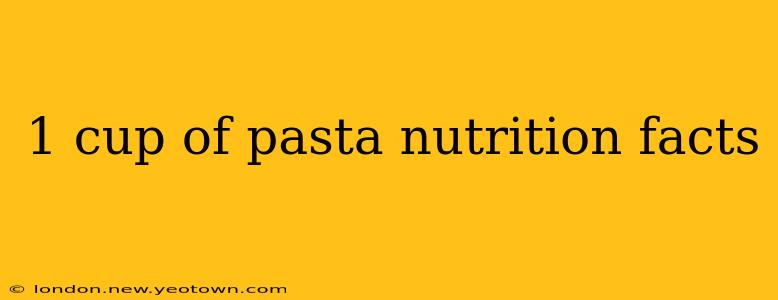One Cup of Pasta: A Nutritional Deep Dive
Pasta. The very word conjures images of comforting family dinners, vibrant Italian landscapes, and the satisfying slurp of perfectly cooked noodles. But beyond the deliciousness, what's actually in that steaming bowl of pasta? Let's unravel the nutritional facts of a single cup, exploring its benefits, drawbacks, and how to make it a healthier part of your diet.
Our journey begins with the understanding that "one cup of pasta" is a broad term. The nutritional content varies dramatically depending on the type of pasta – whole wheat, enriched, gluten-free, etc. – and its preparation method. However, we can establish some general guidelines based on a typical serving of cooked, enriched pasta.
A Typical Nutritional Profile (per 1 cup cooked, enriched pasta):
- Calories: Approximately 200-220
- Carbohydrates: Around 40-45 grams (mostly complex carbohydrates)
- Protein: Approximately 8 grams
- Fiber: Relatively low, usually under 3 grams (unless it's whole wheat)
- Fat: Very low, typically under 1 gram
It's important to note: These are estimates. Always check the nutrition label on the specific pasta package you're using, as variations exist.
What are the benefits of eating pasta?
Pasta, particularly whole wheat varieties, can offer several nutritional advantages:
- Energy Source: The carbohydrates in pasta provide a readily available source of energy, making it ideal for fueling physical activity.
- Complex Carbohydrates: Enriched pasta offers a blend of complex and simple carbohydrates, offering sustained energy release, unlike simple sugars that cause energy spikes and crashes.
- Essential Nutrients: Enriched pasta is fortified with essential vitamins and minerals like iron and B vitamins. Whole wheat pasta also provides additional fiber and micronutrients.
- Versatility: Pasta's versatility is undeniable. It serves as a fantastic base for a myriad of healthy and flavorful dishes, allowing for creative incorporation of vegetables, lean proteins, and healthy fats.
Is pasta bad for weight loss?
This is a question often asked, and the answer is nuanced. Pasta itself isn't inherently bad for weight loss. The key lies in portion control and the overall context of your diet. A single cup, as discussed above, contains a moderate amount of calories. Overconsumption, however, can lead to weight gain. Focusing on whole wheat pasta, incorporating plenty of vegetables and lean protein in your pasta dishes, and practicing mindful eating habits are crucial for weight management.
What type of pasta is healthiest?
Undeniably, whole wheat pasta emerges as the healthiest option. Its higher fiber content promotes better digestion, contributes to satiety (feeling full), and aids in regulating blood sugar levels. Look for options with minimal added ingredients and high fiber content.
Does pasta raise blood sugar?
The glycemic index (GI) of pasta varies significantly based on its type. Refined pasta (white pasta) tends to have a higher GI, leading to a more rapid spike in blood sugar. Whole wheat pasta, with its higher fiber content, boasts a lower GI, resulting in a gentler and more gradual release of glucose into the bloodstream. This makes it a better option for individuals managing blood sugar levels, such as those with diabetes.
Is pasta a good source of protein?
While pasta does contain protein, it isn't considered a primary protein source. The protein content is relatively modest, around 8 grams per cup. To ensure adequate protein intake, it's essential to pair pasta dishes with lean protein sources like chicken, fish, beans, or lentils.
Can I eat pasta every day?
Moderation is key. While incorporating pasta into your diet regularly isn't necessarily harmful, especially if you opt for whole wheat varieties, consuming it daily without mindful portion control could contribute to excess calorie intake and potentially hinder weight management goals. A balanced diet that encompasses a variety of food groups is always recommended.
Ultimately, a cup of pasta can be a delicious and nutritious part of a balanced diet. By making informed choices about the type of pasta, portion sizes, and accompanying ingredients, you can enjoy its culinary benefits without compromising your health goals. Remember to always check nutrition labels for accurate information and adapt your consumption based on your individual dietary needs and preferences.

